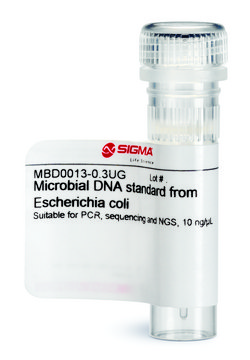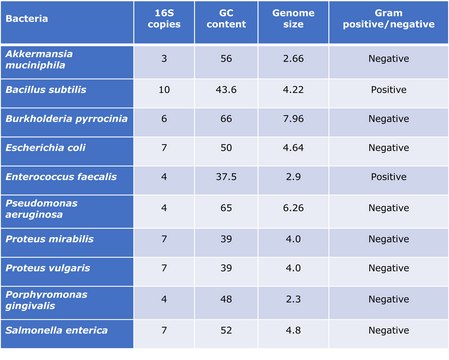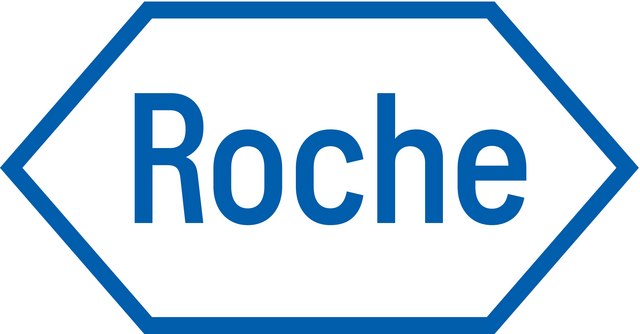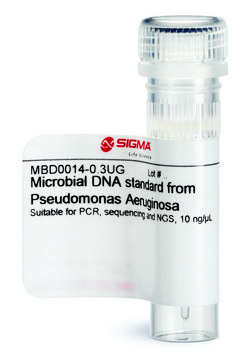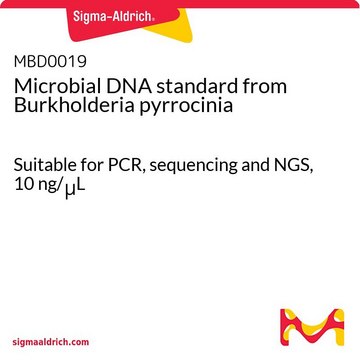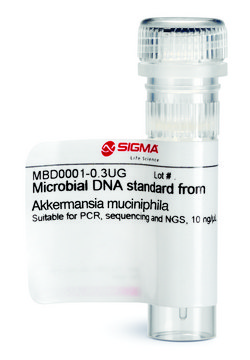MBD0002
Microbial DNA standard from Proteus mirabilis
Suitable for PCR, sequencing and NGS
Sign Into View Organizational & Contract Pricing
All Photos(2)
About This Item
UNSPSC Code:
12352200
NACRES:
NA.24
Recommended Products
Quality Level
form
liquid
concentration
10 ng/μL
technique(s)
DNA extraction: suitable
DNA sequencing: suitable
PCR: suitable
shipped in
ambient
storage temp.
−20°C
Related Categories
General description
Standardization of sample analysis is currently needed in microbiome genomics research workflow. Lack of standardization can lead to biases and errors in common processes during sample preparation and analysis such as sample amplification, sequencing and bioinformatics analyses.1 Proteus mirabilis genomic DNA microbial standard can serve as standard for benchmarking the performance along the workflow of microbiomics or meta-genomics analyses and as a tool to increase reproducibility and allow comparison of results obtained by different labs.
Proteus mirabilis is a gram negative facultative anaerobic rod-shaped bacterium. Bacteria of the genus Proteus of the family Enterobacteriaceae are opportunistic human pathogens responsible for wound and burn infections as well as skin, eye, ear, nose, throat, urinary tract, and gastrointestinal infections and bacteremias.2 The most common infection involving P. mirabilis occurs when the bacteria, which is a member of the natural intestinal flora, moves to the urethra and urinary bladder causing urinary tract infection. The outer-membrane lipopolysaccharide (LPS) is considered an important virulence factor of Proteus.3 Arabski et al. suggest that the immunological response against P. mirabilis LPS might play a role in rheumatoid arthritis.4 A possible correlation between the abundance of P. mirabilis in the intestine and obesity was suggested recently.5
Read here how to use our standards to ensure data integrity for your microbiome research.
Proteus mirabilis is a gram negative facultative anaerobic rod-shaped bacterium. Bacteria of the genus Proteus of the family Enterobacteriaceae are opportunistic human pathogens responsible for wound and burn infections as well as skin, eye, ear, nose, throat, urinary tract, and gastrointestinal infections and bacteremias.2 The most common infection involving P. mirabilis occurs when the bacteria, which is a member of the natural intestinal flora, moves to the urethra and urinary bladder causing urinary tract infection. The outer-membrane lipopolysaccharide (LPS) is considered an important virulence factor of Proteus.3 Arabski et al. suggest that the immunological response against P. mirabilis LPS might play a role in rheumatoid arthritis.4 A possible correlation between the abundance of P. mirabilis in the intestine and obesity was suggested recently.5
Read here how to use our standards to ensure data integrity for your microbiome research.
Application
Suitable for Quantitative standard for PCR, Sequencing and NGS
Features and Benefits
- Individual microbial standard for microbiomics and meta-genomics workflow
- Suitable standard for PCR, sequencing and NGS
- Improve Bioinformatics analyses
- Increases reproducibility
- Compare results lab to lab
Physical form
Liquid -The genomic DNA is provided at ≥10 ng/μl concentration in TE buffer pH 8.0
Storage Class Code
12 - Non Combustible Liquids
WGK
WGK 1
Flash Point(F)
Not applicable
Flash Point(C)
Not applicable
Choose from one of the most recent versions:
Certificates of Analysis (COA)
Lot/Batch Number
Don't see the Right Version?
If you require a particular version, you can look up a specific certificate by the Lot or Batch number.
Already Own This Product?
Find documentation for the products that you have recently purchased in the Document Library.
Our team of scientists has experience in all areas of research including Life Science, Material Science, Chemical Synthesis, Chromatography, Analytical and many others.
Contact Technical Service